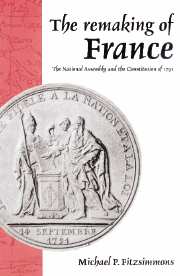6 - The realization of the new ideal of the polity
Published online by Cambridge University Press: 14 October 2009
Summary
From Colloumiers-en-Brie – Every Sunday and holiday the mayor and municipal officers gather the people in a church, and read and explain to them all the decrees that the National Assembly has conveyed during the week, encouraging concord, peace and attachment to the constitution. All villages and hamlets ought to follow this example.
Journal des municipalités et assemblées administratives, May 24, 1790As the year 1790 began the nation existed in a void that was to be filled by the National Assembly. Virtually all of its major institutions had disappeared, and it was an indication of the omnipotence of the Assembly that on a daily basis it reshaped the face of France, remaking provinces into departments in a process that many deputies found stultifying even as they recognized its overriding importance. But pockets of resistance to the new ideals of the Assembly remained, and the anxiety created by the air of uncertainty was palpable. This tension crystallized around two incidents early in 1790: the summoning of a defiant Chamber of Vacations of the Parlement of Rennes and the arrest and trial of the marquis de Favras.
In January, 1790, the task of defining the boundaries of departments was proceeding apace; by early January, in fact, approximately sixty departments had been determined. Although deputies recognized that this was an undertaking of the highest magnitude, there were meetings during this process when attendance was quite low, and most often the Assembly simply adopted the advice of the Committee of the Constitution.
- Type
- Chapter
- Information
- The Remaking of FranceThe National Assembly and the Constitution of 1791, pp. 176 - 216Publisher: Cambridge University PressPrint publication year: 1994

